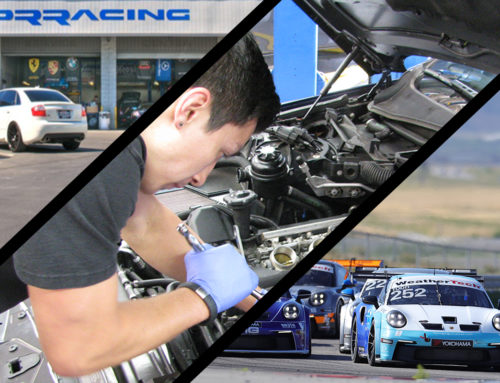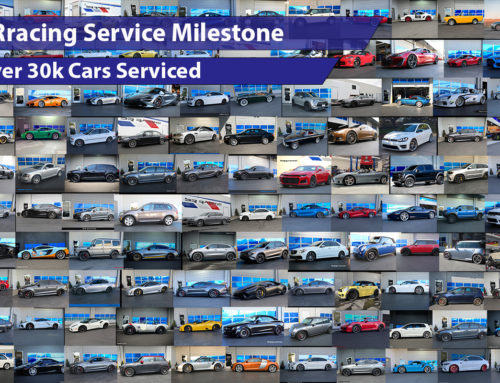We often read the various magazine reviews about the new sports cars and exotics, and really wonder if they are going to be all that the reviews say they are. Often, they are not, and reality is much different…..which you don’t know till much later.
One of the new cars, exotics, that has been highly acclaimed and heralded is the entry of the new McLaren MP4-12C. When you read the specs, you just stand in awe, and we all know what McLaren can do….but is this street exotic truly great?
One of our customers recently had the opportunity to truly do a full test drive of the car in the Bay Area, and has shared with us their findings….read on to see what this new car is like for a daily driver here in the Bay Area.

This great write up was penned by April (BRracing customer)….a great write up indeed –
The local dealer was kind enough to extend an invitation to test drive the new MP4-12C, so I drove our Ferrari 458 Italia the 15 miles to the McLaren dealer.
Upon arrival, the salesperson conducted me to a demo car that he indicated was loaded with every option except carbon brakes and the louder inconel exhaust system. Lots of carbon trim inside, in the engine bay, and even on the exposed from wheel tubs when the door opened, super-light wheels, etc. There is no telling how a base model would have changed my perceptions.
Opening the door of the MP4-12C was interesting with the proximity sensor switch under the character line. There is no pad or button – just smooth paint. (Makes me wonder what will happen when the battery goes dead) The angle of the semi-gull wing door as it swung wide was a logistical concern from the standpoint of garage clearance. You’d be hard pressed to fit it under a 2 post lift or very close to another car needing some door room. I put my feet into the narrow pedal box and then slid my bottom over the wide sill. There doesn’t appear to be any way to gracefully enter the car, and numerous scuffs on the leather of the lower outside dash suggested that people’s shoes had not cleared the leather there. In some ways shades of the Lotus Evora. The door was a bit hard to pull down for a smaller person like myself, due to the angle and resistance from the strut, but not impossibly so. It required a firm heave to latch however. No clunks, rattles or other unwanted sounds.
Power seats were adjustable either while the car was running, or when the door was open. But not when the car was turned off and door closed.
While most folks might remark on the climate control switches on the doors, I wished the seat controls were placed in a slightly more ergonomic location. They were under the edge of the front of the seat next to the tunnel, so you needed to lean forward to adjust. That all highlights how tight space is inside the car. It’s MUCH smaller than the 458. Not much space behind the seats, no door pockets, etc. The center stack is very narrow, with only a small sprinkling of buttons, the doors loom close, and even the seats are narrow. The dash is somewhat if not hugely lower than the 458, and the side mirrors are at least as informative as the 458, but views out of the rear are perhaps even more restrictive. Both feature a nice view of the front fender arches.
Something extremely distracting were the vertical ripples in the windshield. Looking across at a angle made them quite evident.
Once in place, I noted the seats were more snug than the 458. A good thing for smaller humans, but it might prove a challenge for larger folks. Not sure how larger seats might fit if available since the wide sills and fat doors take up a lot of width. However, the ones in the car allowed me to find a comfortable position quickly – rare in my case. I didn’t play with the stereo or center stack. News on McLaren forums have suggested that the I.R.I.S. (touch screen interface) system is still in gestation, with only the radio and media player functioning, while missing the track data, nav, and phone system. Claims were that the factory had delayed release of the car in part due to this.
I inserted the key into the column and pushed the unremarkable silver (the Ferrari one is bright red) ‘start’ button on the center stack produced a mild roar, then the engine settled into a grumble. Not quite as refined at tickover as the new 458, but not exactly rorty.
Upon setting out, what was immediately obvious was the smoothness of the ride in normal mode. It was amazing. Stuff that had us jiggling in the 458 even on the “bumpy road suspension setting” were glossed over nearly as well as the Maserati GT-S in the baby Mac! The Maser is a long wheel base car that does a marvelous job of soaking up vibrations while being sporty. Stunning job by McLaren. Moving into sport mode had us riding in comfort similar to the Ferrari’s regular street “sport” mode. Track mode in the McLaren was very harsh and really meant for track. It would be hard to find traction on our cratered streets in that mode.
A nice touch was that there were two small dials on the center stack that allowed you to control suspension and engine/drivetrain independently. Just 3 positions for each. ‘Standard’, ‘sport’, and ‘track’. So engine noise and shift firmness were controlled separately from the ride. Very simple one the surface (although you can go into the menus and adjust the levels for each setting). The dash display showed the status of all with a simple bar graph. The shifter paddles followed normal convention of right for upshift and left for downshift, although requiring a firmer tug than most other paddle shifts I’ve used. Alas the shifter paddles rotate with the steering wheel and they are quite small. Fine on the track where the wheel never turns far, nor would you want to shift in a corner, but annoying for the street. I foresee larger fixed paddles in the future. Neutral could only be selected by hitting a button in the center stack, not by pulling back both paddles simultaneously as in Ferrari or Lamborghinis. This is just a personal quibble, but I like to pop the car into neutral a short distance before stopping for a light, so that the dual clutch transmission can complete it’s downshifts a bit more smoothly, while disengaged from the rest of the drivetrain.
Shift quality in ‘normal mode” with the dual clutch gearbox was about on par with other such systems offered by Porsche, Audi, BMW, and Ferrari. Acceptable, but not as smooth as a good stickshift driver. It works best during continuous acceleration, not mixed throttle states. And like all systems, it’s possible to ‘outsmart’ the gearbox by choosing a gear it was not expecting you to choose, causing a lurch and clunk. In the middle ‘sport’ mode, the shift quality was very firm – just shy of harsh. Almost, but not quite as violent as say a Ferrari Challenge Stradale in street mode, or a Lamborghini Gallardo in ‘corsa’. In ‘race’ is was easily as abrupt as the CS in ‘race’ mode. Please note I never did try the ‘auto’ mode, since I never drive paddle cars in that mode.
The MP4-12C does creep forward when you release the brake from a halt. The 458 stays in place until you touch the throttle.
The steering wheel was markedly smaller than the 458, and lacking many of the steering located controls. That said, feedback was MUCH more natural than the 458 for a first time user. There was none of the sometimes odd kingpin angle sensation you get in the 458 just off center. Assist was very linear. This was actually aspect I liked best about the McLaren.
The steel brakes felt like they had weak initial bite (panic!), but turned out to be incredibly easy to modulate at low speeds when compared to the carbon brakes of the 458. No lurching stops! No idea how the optional carbon stoppers would feel, but unless spending a lot of time at the track, the steel disks might be the more civilized choice. I didn’t have much chance to explore high speed braking as I didn’t break the ton, but everything seemed very linear. Given the forced induction nature, engine braking was respectable, if not exactly fierce as in the 458.
Finally we arrived at the engine. Not especially refined at idle when compared to the 458, but still rather remarkable given that sports exotics of not very long ago spluttered, splatted, and were generally not very happy at low rpms. It pulled briskly from idle, but predictably once the tach swung past 3000 rms, things woke up really really quickly thanks to the twin turbos! There was an odd almost infinitesimal pause as the tach swung past 3000 rpms – maybe an intake tract runner switching over for the extra demands of the turbos? Easily as quick as the 458 in gear, even if the delivery was quite different. In the 458 you downshift to gain revs to make power. In the Mac, you just give the turbos a moment to build boost. Each happens in nearly the same space of time, but clearly the driving style needs to be adjusted.
The sound was a massive let-down for me. Mechanical, but maybe not in the best way possible. Different in note, but similar to the Porsche 997 turbo. Purposeful might be the best way to describe it. It has a hard thrummy aspect I did not especially care for coming from years of Italian car ownership. The dial on the stack could be switched to open a tube from the engine bay to the cabin (outside noise doesn’t change), which made things much louder, but in either case it’s not my idea of a perfect engine note. This might be a case where McLaren needs to suck up and do something like the new turbo M5 – create an artificial soundtrack of how the car would sound under ideal situations and then play it back via the trunk mounted stereo system whenever the car is switched on as a kind of backup singer to the real sound.
Since the car was new to me and I didn’t own it, I didn’t even begin to probe the boundaries. However, at sane speeds, it was at once a more comfortable car to drive, and despite the purposefully minimalist appointed interior surroundings, a less special car to inhabit. There is no telling whether with more practice (at higher speeds) one would continue to explore nuances of character that were not immediately evident, or whether it has a single character. That said, it was clearly a very focussed car, if not exactly passionate. More of an ultimate Nissan GT-R?
The salesperson suggested the McLaren was all about producing the quickest numbers, and not about show-boating, thus it’s understated demeanor when compared to the Italians. Let’s face it, most of us aren’t professional race car drivers, able to wring the last ounce of performance out of a car. Thus so long as the numbers are similar, it all comes down to personal preference and “feel”. There is no wrong choice at this level. There will always be a faster car in the future, so numbers aren’t everything.
I came back from the 25 minute test drive (we had to cut it short) thinking that at “normal speeds” if offered in stickshift, I would probably pick the McLaren over a stickshift 458 for a daily. Alas that is not destined to be be offered in either car. It feels more civilized and exploitable at lower speeds. That might change upon exposure to more speed and familiarity. Just because the McLaren felt friendlier upon first acquaintance does not mean it’s a great car in the long run. Great cars often require more seat time to recognize the nuances of how special they are. Initially they often terrify you. ;)
However, neither is my ideal car by any stretch, as wonderful as they might be. They don’t make my nerve endings “fizz” long after the test drive is over, so please take my review with a grain of salt. McLaren dealers are being fairly open handed with test drives at the moment, so I suggest you form your own conclusions.
And let’s not forget that this is version 1.0. Who knows what surprises lay in store? Word is that several owners have sold/had their cars bought back due to numerous software and safety updates. You can follow the online McLaren community here: http://www.mclarenlife.com/forums/mclaren-mp4-12c-p11/
Online brochure: http://www.millermotorcars.com/contentimages/media/9f4a24ecfdf86199fff382000a39b114.pdf
Note: The MP4-12C does not offer a nose lift option. The 458 sits taller, but the nose juts out further. Overall clearance is likely similar, which while not great, is workable in most instances. Ferrari however does offer a nose lift option.

Note: Front trunk space was about the same width as the 458, but with slightly less depth and length. Much more useable than any Lamborghini, but if throwing in a couple of helmets and track suits, there wouldn’t be much extra space left over.
Note: The McLaren factory has the final capacity of producing 4000 cars (across all models) a year. However, their past record with producing the F1 and Mercedes SLR have indicated that it may take time and luck to reach full capacity. This means potentially soft resale.
Note: Oh, and nobody waved, honked, or took our picture. Not that I like that aspect, but it’s something to take note if you want attention with your $200K+ exotic. Traveling in a red Ferrari is like traveling with a circus (give me the cloaking device to make the Ferrari look like a Camry please). The McLaren is not. Maybe it was just the deep Volcano Red (almost maroon) shade of our tester.
Final note: The dealer had both the Volcano Red car, a SuperNova Silver car, and McLaren Orange car. The orange looks stunning, although sure to be a cop magnet. The Volcano thoroughly pleasant, if maybe not special enough, and the metallic flakes in the SuperNova paint were just too large for my tastes, making the car look a bit like a Matchbox special. However, the silver car did have the mid-level split spoke light weight wheels, and those looked incredible! Also reasonably easy to clean.





g
whoah this www is great i like studying your articles.
Keep up the good work! You understand, a lot
of people are looking round for this info, you can aid them greatly.
Ranbuild
84 Boat Harbour Drive Pialba QLD 4655?
(07) 4124 2099
Right here is the perfect webpage for anybody who
really wants to find out about this topic. You understand so much its
almost tough to argue with you (not that I actually
would want to
Can I just say what a relief to find somebody that genuinely understands what they’re talking about on the net.
You actually realize how to bring a problem to light and make it
important. More and more people must read this and
understand this side of your story. I can’t believe you are not more
popular given that you surely possess the gift.
I have not checked in here for a while because I thought it was getting boring, but the last several posts are great quality so I guess I’ll add you back to my everyday wwwlist. You deserve it my friend :)
Thanks for finally talking about >McLaren MP4-12C – customer review – BR Racing Blog <Loved it!